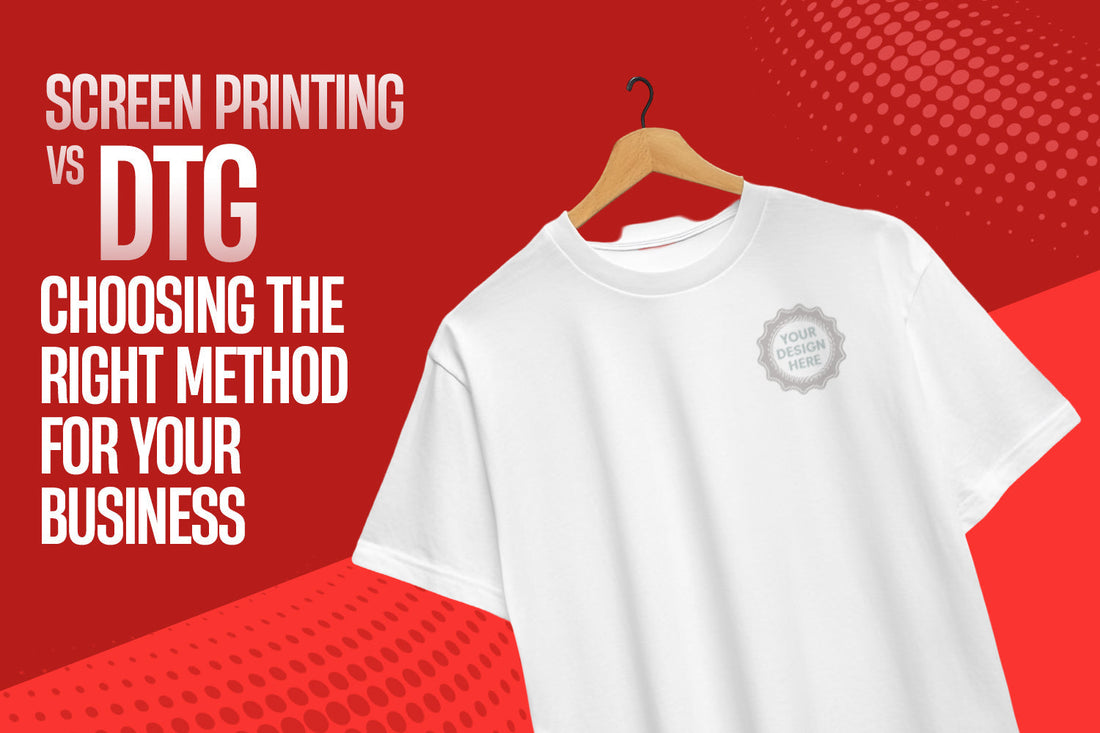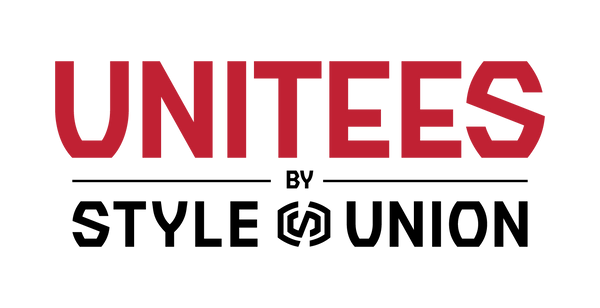
Screen Printing vs DTG: Expert Insights to Help You Make the Smart Choice
When it comes to professional custom-printed apparel, the choice between screen printing vs DTG can make all the difference in the quality, durability, and overall impact of your clothing. For businesses, institutions, and event organisers, the printing method you select will directly influence how your brand is perceived and how long your garments maintain their professional look.
At Unitees by Style Union, we specialise in delivering premium-quality, bulk printed apparel that blends style, comfort, and brand consistency. From ready-made round neck t shirt printing for teams to personalised t shirt printing for events, our expertise lies in providing reliable logo printing on garments that truly represent your identity.
In this guide, we’ll provide in-depth, practical insights into screen printing vs DTG, helping you choose the best method for your specific needs — whether that’s outfitting an entire workforce, creating merchandise for a promotional event, or developing branded clothing for long-term use.
What is Screen Printing?
Screen printing, also called silk screen printing, is one of the most established techniques in custom apparel production. It involves creating a stencil (or “screen”) for each color in a design, then pressing ink through the screen onto the fabric.
Key Advantages of Screen Printing for Businesses
- Ideal for Bulk Orders
- Long-Lasting Print Quality
- Sharp and Bold Colors
-
Versatile Fabric Compatibility
Best Use Cases for Screen Printing
- Large-scale round neck t shirt printing orders for corporate events.
- Branded uniforms for hospitality, retail, and service industries.
- Merchandise for concerts, sports teams, or promotional giveaways.
Screen printing is the go-to choice when your priority is durable, consistent branding across a large quantity of garments.
What is DTG Printing?
DTG, or Direct-to-Garment printing, is a modern printing method that uses specialised inkjet technology to apply designs directly onto the fabric. Instead of using screens, DTG sprays the ink into the fibres of the garment, allowing for high-resolution prints with intricate details.
Key Advantages of DTG Printing for Businesses
-
Perfect for Detailed Designs
Captures gradients, fine lines, and photographic elements without losing clarity. -
No Minimum Order Requirement
Suitable for small batches or one-off items, making it a good choice for personalised t shirt printing. -
Quick Setup Time
Without screens, production can start immediately after the design is finalised. -
Soft, Comfortable Finish
The ink soaks into the fibres, creating a smooth print that feels natural on the garment.
Best Use Cases for DTG Printing
- Customised apparel for events where each garment needs a unique name or design.
- High-detail designs with multiple colors or photographic images.
- Limited-edition or short-run merchandise for promotional campaigns.
DTG printing is the preferred choice when you need flexibility, intricate detail, and small-batch efficiency without compromising print quality.
Screen Printing vs DTG: Side-by-Side Comparison
Understanding the difference between screen printing vs DTG comes down to a few key factors: order size, design complexity, durability, and cost.
1. Order Size and Cost Efficiency
- Screen Printing: Most cost-effective for bulk orders. Once the screens are made, printing hundreds or thousands of garments becomes faster and cheaper per unit.
- DTG Printing: More suitable for small runs or one-off designs. The cost per garment remains consistent regardless of quantity, which works well for limited orders.
2. Design Complexity
- Screen Printing: Best for solid-color logos, bold graphics, and minimal detail. Each color requires a separate screen, so complex designs increase setup time.
- DTG Printing: Excels with intricate, multi-color designs, gradients, and photographic images without additional setup.
3. Durability and Wear
- Screen Printing: Produces thick, vibrant prints that withstand frequent washing without significant fading, making it ideal for uniforms and high-use apparel.
- DTG Printing: Still durable but may show signs of wear sooner than screen printing if exposed to heavy washing or rough use.
4. Fabric Compatibility
- Screen Printing: Works on a wide range of fabrics, including cotton, polyester, blends, and specialty materials.
- DTG Printing: Performs best on 100% cotton for sharp, vibrant results, with reduced vibrancy on synthetic blends.
5. Turnaround Time
- Screen Printing: Requires more time for initial setup but produces bulk orders quickly once prepared.
- DTG Printing: Minimal setup means production can start almost immediately, making it faster for small orders but slower for very large ones.
In short, screen printing is the better choice for long-lasting, large-scale brand visibility, while DTG is ideal for personalised t shirt printing and designs with intricate details.
When to Choose DTG Printing for Your Business
There are times when flexibility and design detail matter more than large-scale cost savings. That’s where DTG printing stands out. Instead of committing to hundreds of identical garments, this method lets you create apparel with unique, high-quality prints for smaller, more targeted campaigns.
For example, if you’re preparing personalised t shirt printing for a corporate retreat where each employee’s name appears alongside the company logo, DTG handles the task with ease. It’s also perfect for short-run merchandise or event apparel that demands photographic clarity and multiple colors.
The ability to print complex designs without additional setup makes DTG especially valuable for:
- Limited-edition brand collaborations.
- Small-batch promotional items for VIP clients.
- Creative campaigns where every garment is a one-off.
At Unitees, we recommend DTG when your priority is design precision, quick turnaround for small orders, and the freedom to personalise each piece without inflating production costs.
How Fabric Choice Impacts Printing Quality
No matter how advanced the printing method, the quality of your apparel starts with the fabric. The right material ensures your prints stay sharp, vibrant, and comfortable to wear — and that’s where Unitees’ expertise comes in.
Fabric Considerations for Screen Printing
Screen printing is highly adaptable, working well on cotton, polyester, blends, and even specialty fabrics. This flexibility allows businesses to choose garments that suit their branding needs, from lightweight promotional tees to durable workwear.
Fabric Considerations for DTG Printing
DTG thrives on 100% cotton fabrics. Cotton fibres absorb the ink deeply, producing rich colors and precise details. While DTG can be used on blends, the vibrancy may be reduced, making fabric choice critical for top results.
Why Unitees Focuses on Ready-Made, High-Quality Apparel
By offering round neck t shirt printing, polos, and activewear in premium fabrics, Unitees ensures that whichever method you choose — screen printing or DTG — the final product meets both durability and comfort standards. This commitment means your garments look great on day one and maintain their appeal over time.
Cost Considerations and Order Planning
Budget plays a major role in deciding between screen printing vs DTG, especially for businesses managing bulk apparel requirements. Understanding how costs scale with order size and complexity will help you make the most profitable choice.
Screen Printing Cost Structure
Screen printing involves an initial setup for each color in the design, which can make the upfront cost slightly higher. But once the setup is complete, the cost per garment drops significantly for large batches. This makes it the smart option for:
- Corporate uniforms ordered in bulk.
- Large event merchandise with a single, consistent design.
DTG Cost Structure
DTG has no screen setup, so you avoid high upfront costs, making it better for smaller orders. However, the cost per piece remains constant regardless of quantity, which is why it’s ideal for:
- Limited-edition apparel.
- Campaigns that require personalised t shirt printing.
Planning Your Order for Maximum Value
- For Large Quantities: Choose screen printing for long-term cost savings and durability.
- For Short Runs or Multiple Designs: Choose DTG for flexibility and detail without added setup fees.
At Unitees, we help clients plan orders strategically — balancing cost, branding goals, and delivery timelines to ensure every garment delivers measurable brand impact.
Branding Impact and Print Quality
Custom-printed apparel isn’t just clothing — it’s a walking representation of your brand. The method you choose between screen printing vs DTG plays a big role in how your brand is perceived by clients, customers, and the public.
Screen Printing for Bold Brand Presence
Screen printing produces solid, vibrant colors that hold their intensity over time. This makes it ideal for logos and branding elements that must remain visually consistent, especially across large teams. Whether it’s round neck t shirt printing for retail staff or event uniforms, the bold, high-contrast look leaves a lasting impression.
DTG Printing for Creative and Detailed Branding
DTG excels when your brand identity involves intricate designs, full-color graphics, or photographic elements. It captures fine detail and subtle gradients, making it perfect for limited-edition or high-visual-impact pieces, such as personalised t shirt printing for VIP giveaways or media events.
Why This Matters for Your Business
Consistent, high-quality prints communicate professionalism and trustworthiness. At Unitees, we ensure that both screen printing and DTG meet strict quality checks so your apparel not only carries your brand but also strengthens its credibility.
Turnaround Times and Delivery Reliability
Deadlines are non-negotiable when it comes to business events, product launches, or staff uniform updates. The ability to deliver on time can make or break a project.
- Screen Printing: The setup process is longer, especially for multi-color designs, but once the screens are prepared, large volumes can be printed quickly and efficiently.
- DTG Printing: Minimal setup allows production to start almost immediately, making it the faster option for smaller orders. However, very large batches may take longer than screen printing to complete.
At Unitees, we pride ourselves on timely delivery, whether you need a quick DTG run for a promotional event or a large-scale screen printing order for a corporate rollout. Our process ensures quality control without compromising speed.
Expert Recommendations from Unitees
Choosing between screen printing vs DTG comes down to three main factors: quantity, design complexity, and intended use.
- Opt for screen printing if you want long-lasting, cost-efficient branding for large teams, repeated events, or high-demand merchandise.
- Opt for DTG printing if you need smaller runs, unique prints, or high-resolution designs that can’t be achieved with solid-color screens.
Many businesses we work with choose a combination — screen printing for bulk round neck t shirt printing and DTG for smaller, personalised t shirt printing needs within the same campaign. This hybrid approach maximises budget efficiency and brand impact.
Conclusion
The screen printing vs DTG decision is not just about choosing a printing method — it’s about selecting the right strategy for your brand’s apparel. Screen printing offers unmatched durability and cost savings for large orders, while DTG provides design flexibility and quick turnaround for smaller batches.
At Unitees by Style Union, we deliver both options with a focus on premium garment quality, precision logo application, and dependable delivery. Whether you’re outfitting your staff, launching a promotional campaign, or gifting branded apparel to clients, we ensure every piece strengthens your team identity and enhances brand presence.
Ready to make the smart choice for your next custom apparel order? Contact Unitees today to discuss your printing needs and get expert guidance tailored to your business goals.
